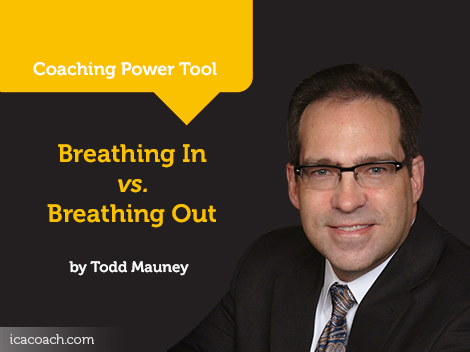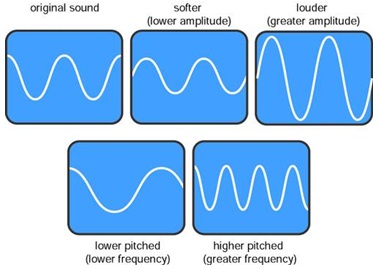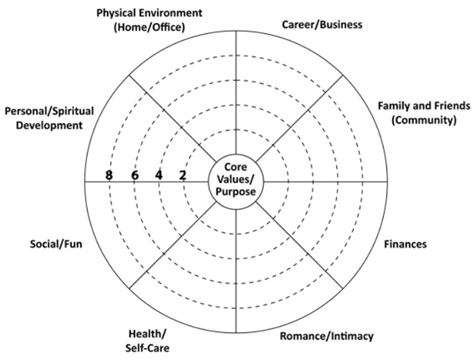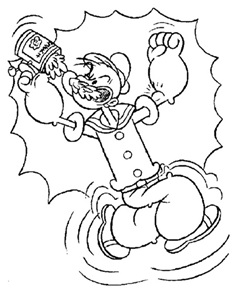
A Coaching Power Tool Created by Todd Mauney
(Business Coach, USA)
From the beginning of time, God established a rhythm of life – of being and doing – of breathing in and breathing out which is essential for the sustaining of all life. However, we have often adopted our own alternative rhythm of doing, doing, doing – of breathing out, breathing out, breathing out.— Beth M. Crissman, Plowpoint
Introduction
The concept of “breathing in” and “breathing out” applies in all aspects of our lives. It has profound implications on our physical bodies, relationships, spirituality, careers and even our businesses. It’s about tapping into a natural and universal law of rhythm and seasons in life. We all live our lives in a variety of contexts and circumstances. The intent of this writing is to raise awareness of when this concept is playing out in life and work and moreover, learn how to leverage it for better results and improved quality of life.
While the concept is simple, it can be applied in a number of ways. Consider the following contrasting perspectives as they relate to the title of this power tool:
 Each perspective takes on a different connotation and meaning based on the context in which it is applied. Yet they all have something in common…oscillation. According to Wikipedia, “oscillations occur not only in mechanical systems but also in dynamic systems in virtually every area of science: for example the beating human heart, business cycles in economics, predator-prey population cycles in ecology, geothermal geysers in geology, vibrating strings in musical instruments, periodic firing of nerve cells in the brain, and the periodic swelling of Cepheid variable stars in astronomy.” Managing these oscillations is a central theme in life and essentially the heartbeat that sustains and enhances it.
Each perspective takes on a different connotation and meaning based on the context in which it is applied. Yet they all have something in common…oscillation. According to Wikipedia, “oscillations occur not only in mechanical systems but also in dynamic systems in virtually every area of science: for example the beating human heart, business cycles in economics, predator-prey population cycles in ecology, geothermal geysers in geology, vibrating strings in musical instruments, periodic firing of nerve cells in the brain, and the periodic swelling of Cepheid variable stars in astronomy.” Managing these oscillations is a central theme in life and essentially the heartbeat that sustains and enhances it.
Many tend to grasp and orient themselves towards one side of these contrasting oscillations more than the other leading to frustration, disappointment, burnout and a sense of dysrhythmia. They become trapped in a seemingly endless state of “imbalance” where, like a sound wave, there’s more noise than music. Let’s look at the “Breathing Out” side of this analogy.
Breathing Out
When the body is deprived of oxygen, we can develop what’s known as hypoxemia or hypoxia. This is a dangerous condition with early symptoms of confusion, forgetfulness, shortness of breath and rapid breathing which can quickly damage the brain, liver and other vital organs. As human beings we need oxygen or we will suffer terrible mental and physical consequences. As Beth points out in her quote, when we’re going, going, going all the time, we’re essentially breathing out without taking in life giving oxygen. Fortunately our brain is hard wired to breathe in but can you imagine only breathing out? Yet, that’s how many people live their lives and even run their businesses, metaphorically breathing out…doing, doing, doing all the time without taking a breath.
Let’s zoom in a little closer to see what this perpetual doing modality looks like in our lives and how it impacts us like hypoxia. Society seems to praise massive action because as renowned life coach and author Tony Robbins puts it, “Action is the most important key to any success.” All of us want “success” and often define it in material terms like a new car, boat or vacation home. Of course these things are wonderful to have, and there’s no shame in having them. However, we often stay so busy doing, we miss out on the things we desire the most like happiness, purpose, fulfillment, connection and joy. Unfortunately, as society has become increasingly addicted to perpetual motion and constant doing, more people are suffering from burnout, emotional drain, energy depletion, fractured relationships, spiritual emptiness and a myriad of physical illnesses like fibromyalgia, heart disease, cancer and diabetes.
Yet, even as we see these consequences in our own lives and those around us, far too many stay on the treadmill of life, running as fast as they can towards something they may never REALLY attain. With each check-off on the bottomless list of to-dos’, we feel an addictive and temporal sense of gratification only to be left with emptiness and discontent on the inside. This perpetual motion keeps us focused on the future where the “prize” exists in our heads rather than in the present. Then when we attain it, there’s no time for celebration because it’s on to the next task, project or goal.
All the constant doing keeps us from getting enough sleep, nourishing our bodies with healthy food, filling our souls with spiritual connection and enriching our lives through meaningful relationships. Like hypoxia, all this breathing out…doing, doing, doing…is “killing” us. And like hypoxia, we also forget who we are, what we really want and how to really attain it. We become confused by the dizzying pace at which we do things. We can fail to slow down long enough to figure out if what we’re doing is really going to achieve what we really want. One of the greatest thought leaders of our time, Peter Drucker, put it this way, “There is nothing as useless as doing efficiently that which should not be done at all.” The doing itself becomes the focus of our attention rather than the purpose for which we do it. We can get so caught up in the process of doing we miss the point of it all, what we really want to experience in life.
Even the business world is full of leaders who’ve fallen into the doing trap, charging up a hill only to find they meant to be on another mountain top. They set daily goals and work really hard day in and day out believing all they have to do to become successful is simply work hard every day. They fail to plan and consequently, plan to fail. This is often where the sewing and reaping metaphor becomes relevant. They make a lot of calls, do a lot of things and are busy all the time. Yet, many business leaders work themselves broke because they didn’t “take a breath” to nurture themselves and their businesses. We’ll look at the other side of this coin shortly, but can you relate to this constant “breathing out” or doing modality?
Right now, I’d like to show you one of my favorite cartoons. It’s a sad, depressing story about a pathetic Coyote who spends every waking moment of his life in the futile pursuit of a sadistic roadrunner, who mocks him and laughs at him as he’s repeatedly crushed and maimed! I hope you enjoy it!— George Newman, UHF
It was fun to watch Wile E. Coyote chase Road Runner every Saturday morning as a child, but it must have really stunk to be him! And that’s exactly how many of us feel chasing the wrong things, always busy trying to do something else to achieve something else. This is what breathing out, the constant doing paradigm, amounts to for so many.
Self-Application
Where are you experiencing hypoxia? Think about when you may be experiencing signs of fatigue, depletion, low enthusiasm, mental block and other symptoms of constant doing or breathing out. One tool which may help you raise awareness is the “Balance Wheel of Life” (Figure 1) which is often used to rate one’s level of satisfaction with different areas of life to represent a picture of balance or imbalance. Figure 1  Using this same tool, we can also become more aware of those areas of our lives where we are excessively “breathing out”…exerting energy, pushing, forcing or doing. Simply think about the amount of exertion you’re applying to these different areas. Shade each slice or area of your life from the center point out to the level you feel represents the amount of effort you’re applying to it. So if you feel you’re pushing hard, working extremely hard and exerting tremendous energy towards your financial circumstances, you’d shade Finances all the way out to the outer circle. If you feel you’re applying minimal energy and exertion on this area, you may only shade to the first circle outside of the center. Once complete you will see how much energy you’re exerting in each of these areas, which then begs the question, how is it improving the quality of your life at a core level. If you see you’re exerting a tremendous amount of energy without seeing how it’s truly bringing more peace, joy and happiness to your life, perhaps it’s time to consider the other side of this dichotomy. Let’s now look at what it means to “breath in.”
Using this same tool, we can also become more aware of those areas of our lives where we are excessively “breathing out”…exerting energy, pushing, forcing or doing. Simply think about the amount of exertion you’re applying to these different areas. Shade each slice or area of your life from the center point out to the level you feel represents the amount of effort you’re applying to it. So if you feel you’re pushing hard, working extremely hard and exerting tremendous energy towards your financial circumstances, you’d shade Finances all the way out to the outer circle. If you feel you’re applying minimal energy and exertion on this area, you may only shade to the first circle outside of the center. Once complete you will see how much energy you’re exerting in each of these areas, which then begs the question, how is it improving the quality of your life at a core level. If you see you’re exerting a tremendous amount of energy without seeing how it’s truly bringing more peace, joy and happiness to your life, perhaps it’s time to consider the other side of this dichotomy. Let’s now look at what it means to “breath in.”
Breathing In
Popeye the Sailor Man is a cartoon fictional character who first appeared in comic strips and later animated cartoons during the 1930s.  Each episode featured Popeye facing some seemingly unsurmountable challenge and a beating by his arch nemesis, Bluto. Down for the count, beaten up by Bluto and overwhelmed by the odds of victory, Popeye would reach for his trusty can of spinach and suddenly become super normal. His energy would explode, fear became courage and solutions to his problems became immediately clear. He’d then perform amazing feats of daring to overcome his obstacles defeat his enemy and win the girl, Olive Oyl.
Each episode featured Popeye facing some seemingly unsurmountable challenge and a beating by his arch nemesis, Bluto. Down for the count, beaten up by Bluto and overwhelmed by the odds of victory, Popeye would reach for his trusty can of spinach and suddenly become super normal. His energy would explode, fear became courage and solutions to his problems became immediately clear. He’d then perform amazing feats of daring to overcome his obstacles defeat his enemy and win the girl, Olive Oyl.
Of course this is a fictional character, but we can learn a lot from Popeye. All of us have at times more than we feel we can handle, balance or achieve. Often times we are beat down by the “Blutos” of life. Like Popeye, we work hard trying to do all the right things only to feel defeated or out of steam. Yet, we also have sources of energy, inspiration and innovation we can access. “Breathing in” is metaphorically about eating our spinach…taking in the oxygen of life and accessing the best of who we are as human “be-ings.” Popeye’s spinach didn’t change who he was at the core of his being but rather expanded it! As a result, he was fully ALIVE and could do amazing things!
The concept of breathing in vs. breathing out is analogous with being vs. doing. We talked about doing but what does it mean to “be” and how does this allow us to “do” better? Think about it, we don’t call ourselves human “doings” but rather human “beings.” There’s a reason for this. It’s commonplace for us to think of the human body as merely an elaborate machine, but we are much more. Understanding who we are as “beings” is the gateway for our “doing.”
For all you “high achievers” out there, fully grasping this will change your life experience in profound ways…your happiness, joy and sense of fulfillment with all that you are and all that you achieve. It will not only help you to achieve more but the achievements you make will mean more to you and others.
Our “Being”
In his book, The Pearl Beyond Price, A.H. Almaas suggests, “At a certain age, very early on in life, each one of us becomes aware of himself or herself as a walking, talking, thinking, feeling being—in short, as a living person. It is such a luminous discovery, but it quickly becomes dull with familiarity. Then we live our lives as if we now know what it is to be human, as if maturing were only a matter of becoming more of what we think we are already. The mystery is gone, and life becomes tedious and repetitive.” Can you relate? Over time, many of us lose interest in our humanness to become more focused on the world around us. Consequently, it only makes sense they would also strive to find answers, solutions, peace, happiness, purpose and joy from external sources…people, places and things. Herein lies the temptation for perpetual “doing” in hopes of attaining all these wonderful things while falling short of our potential.
There’s something almost magical about connecting to our “being” or “essence.” There are many words which describe this part of our human experience; soul, consciousness, heart, astral body. They all suggest and most religions concur, there’s something unique about human beings that set us apart from all other forms of life on earth. This essence or soul is a gateway to greater understanding and peace. It is in the experience of being that we are able to access it in profound ways to discover peace, dreams, joy, meaning and purpose. These discoveries create the foundation of our living experience as humans. They shape our values, reveal the desires of our hearts and point us in the direction of where we are supposed to go on our life journeys. Consequently, they ultimately shape what we DO.
A popular verse from the Bible calls us to “Be still and know I am God.” This suggests that it’s in the “being still” that we can gain knowledge and understanding. It is also implied that in this state we tap into the gateway to a higher power, source of greater understanding and strength. It is in this state that we are made to “recharge” our souls and access the source of energy, passion and hope. This is the space we create to dream and be inspired.
A great man dying from a rare form of bone cancer put it this way, “Being still allows us to focus and reflect on our blessings and allows the Lord to speak to us.” He goes on to say how important it is to him to “find a quiet 10 minutes to be open to the Lord to speak to or as it is so beautifully stated in the verse and song-“be still and know.” Then he sums it up nicely by saying, “this is often so difficult in our busy, hectic world, but so necessary. My still time is each night in bed, spending time in prayer and reflection. This is my peace and re-priming of my “Spiritual Pump” in ending the day and preparing for the next.”
Self-Application
We see how energy is processed in a continuum…energy in, energy out. In the same way, we have become more aware of where we’ve exerted energy and now gaining a better understanding of our need to replenish it. With an open mind for discovery, I invite you to answer a few questions regarding your own life. Write your answers down on this sheet, your journal or somewhere you can reflect on it afterwards:
Reflect on these questions thinking about those different areas of your life where you rated the expenditure of energy. Each area of your life or context may require a slightly different way of “being” in order to gain greater knowledge, understanding, inspiration, peace and joy. Take for instance relationships. Perhaps “being” in this context simply means slowing down your mind to be fully present with the other person, intent on understanding (knowing) what they’re trying to communicate through words, expressions and feelings. This deeper understanding of that person could have a dramatic impact on the relationship and even actions (doing) from either or both of you.
Consider another example. Let’s look at finances, specifically earning more money. Perhaps you’re pushing as hard as you can to generate more sales and convince people to buy your products. If you were to step back from it a bit (being still), you might discover some new ways of appealing to their desire for your products or services. Rather than pushing, now your drawing them or pulling them towards you. Or perhaps you’re a business leader ready to launch a major marketing campaign expected to triple sales and revenues. But because companies are made up of human beings which make up its culture, perhaps the people and culture are not ready for rapid growth. So before pressing forward with those ambitious initiatives, the leader may want to take a breath, find time to “BE” with his/her people to understand where they are and what they need to be prepared to take full advantage of the growth opportunities on the horizon.
There are many applications for this process. The key is to understand that BOTH, “Breathing In” and “Breathing” out, “Being” and “Doing” are necessary to live our best lives. There are times and seasons for both. We each have the opportunity to discover the profound power in this dichotomy of existence in the world. This heightened awareness and clearer understanding can be extremely liberating and can break down so many barriers we work so hard to remove from our paths. Simply put, it can make life much easier.
Coaching Application
As coaches, we are often wise to experience what we understand to be important for the client to experience. This concept is certainly an example of one of them. By looking at our own lives as coaches, we will have a much greater appreciation for the dynamics playing out in the client’s world. We will also have discovered for ourselves how to create a better rhythm of “breathing in” and “breathing out” for our lives and businesses. In turn, this allows us to be fully empathetic, patient and congruent with the client as they figure it out for themselves. And you’ll also likely discover how difficult it can be to recognize and interrupt unhealthy patterns of excessive ‘doing.’ This modality may simply have become a part of their identity. Yet, through self-application, the coach will have a greater appreciation for the importance of ‘being’ in rediscovering who you really are at the core, transcending what you’ve ‘done.’ This discovery can change everything!
We have to also remember the role of a coach is to simply invite the client to greater awareness and discovery. The choice to walk down the path is theirs alone. As you’ll likely learn from self-application, really “getting” this concept can be difficult and perhaps even frustrating. Consequently, it’s important to gauge the client’s readiness to explore the subject and willingness to embrace a paradoxical way of being more effective (being in order to do things better). This is where we must tap into our own source of patience, compassion and understanding by “being” ourselves.
When working with clients, pay attention to feelings and expressions of exhaustion, futility, confusion and frustration. Consider using the “Balance Wheel of Life” as noted earlier to help them identify those areas where excessive “doing” may actually be blocking them from a greater life experience. As a colleague coach put it, “how you do anything is how you do everything.” So while you may isolate one area of their lives where they’re experiencing the most pain and opportunity, be mindful your effecting change in this area will likely create a chain reaction in the others as well.
As was noted at the start, observation would suggest most people seem to be experiencing too much of the “breathing out” and “doing“ than the “breathing in” and “being.” However, keep a watchful eye for the opposite extreme where the client may be doing too much “breathing in” and experiencing a lack of results. You may notice your client saying things like, “it will all work out in time” or “I’m just trusting it will be ok.” Those may sound like appropriate comments but if you see a context of inaction, they could be ways to avoid the fear of taking an important step forward. Another popular phrase, “time heals all wounds” is often too a misnomer. More often than not, it’s what we do with that time that heals our wounds. Consider a client who states they’re constantly praying, meditating, listening and patiently waiting but frustrated nothing is changing. This too can be a problem because as was stated earlier, BOTH “breathing in” (being) AND “breathing out” (doing) are absolutely necessary to sustain and create an abundant life. Our role as coaches isn’t to pre-judge but to simply listen and reveal what the client needs to be aware of in order to strike the right balance for themselves.
Reflections:
- How can you model this concept of “breathing in” and “breathing out” for your clients?
- In addition to the tools within this module, what other ways can you think of to use in helping your clients gain more awareness of their current rhythm of “being” and “doing?”
- What are some structures you’ve found helpful in striking this balance for yourself?
- How can you recognize when a healthy balance has been reached?
- What might cause your efforts to maintain an effective rhythm be disrupted or derailed?
- What can you do to prevent yourself from getting back into an ineffective rhythm?